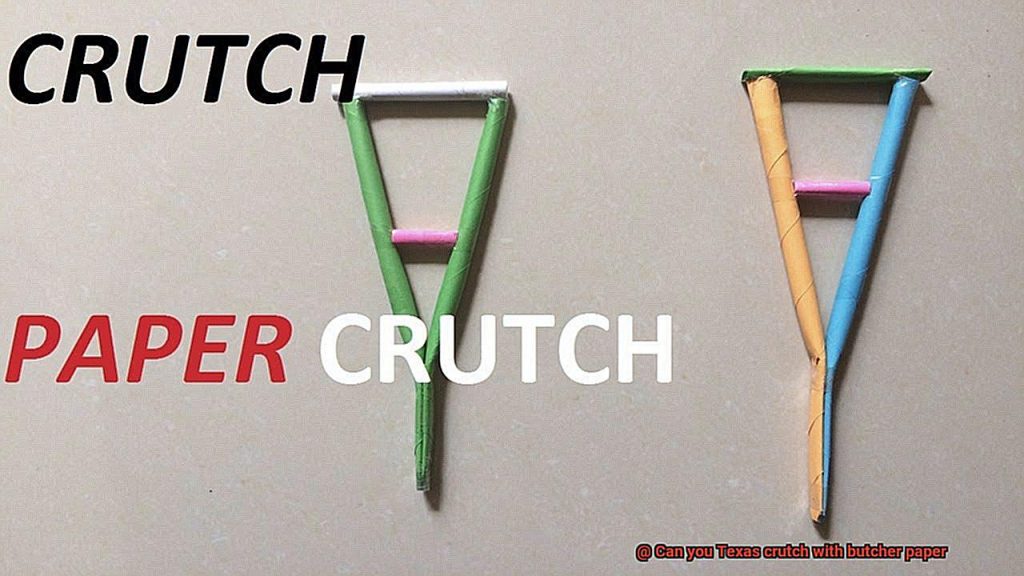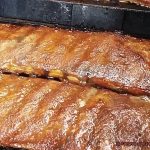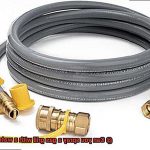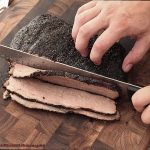Are you a self-proclaimed pitmaster looking to take your BBQ game to the next level? If so, you may have heard of the Texas Crutch technique. This popular method involves wrapping smoked meat in foil after a certain amount of time to create melt-in-your-mouth tenderness and flavor. But, as with any traditional method, there’s always room for improvement.
Enter butcher paper. Many BBQ experts are now opting for this alternative material over foil due to its breathability, which allows smoke flavor to seep into the meat more effectively. Not only that, but it’s also eco-friendly and easily recyclable.
But here’s the burning question: can you Texas crutch with butcher paper? While it offers many benefits over foil, butcher paper doesn’t retain moisture as well which could lead to dry and tough meat if not executed properly.
That’s where we come in. In this blog post, we’ll dive deep into the advantages and challenges of using butcher paper in the Texas Crutch method. We’ll share our expert tips and tricks on how to use it effectively so that you can achieve juicy brisket, ribs or pork shoulder like never before.
So get ready to impress your friends and family with your newfound BBQ skills. Let us show you how to perfect the Texas Crutch with butcher paper and take your BBQ game up a notch.
Contents
Can You Texas Crutch with Butcher Paper?
The Texas Crutch method is a popular smoking technique that involves wrapping meat in foil or butcher paper during the final stages of smoking. Butcher paper is an excellent alternative to foil, as it allows for better airflow and helps create a crispy bark on the outside of the meat.
Butcher paper also offers an added benefit to your meat’s flavor profile. Unlike foil, which prevents smoke from penetrating the meat, butcher paper allows some smoke to seep through, giving your meat that extra boost of smoky goodness that we all crave.
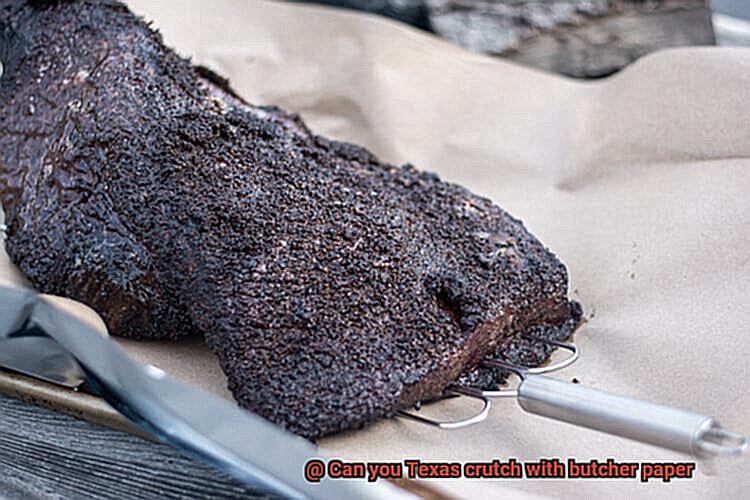
Not only is butcher paper environmentally friendly, but it’s also more sustainable than foil. While foil can take hundreds of years to decompose in landfills, butcher paper can be composted or recycled, making it a more eco-conscious choice.
However, not all butcher paper is created equal. To ensure optimal results, make sure you’re using uncoated, food-grade paper that is free from any harmful chemicals or dyes that could potentially taint your food. A 40-pound weight or higher will also ensure durability during the smoking process.
The Benefits of Using Butcher Paper for Smoking Meat
Look no further than the versatile and durable option of butcher paper. As an expert in the benefits of using butcher paper for smoking meat, let me share with you why this method has become increasingly popular among barbecue enthusiasts.
Firstly, using butcher paper allows the meat to breathe while still retaining moisture, which is vital in the smoking process. Unlike other wraps like aluminum foil or parchment paper, butcher paper allows for airflow through the paper, preventing the meat from drying out and becoming tough. The result? Meat that is juicy, tender and bursting with flavor.
Butcher paper’s durability also sets it apart from other wrapping options. With its ability to withstand high temperatures without tearing or breaking apart, it is perfect for use in the Texas crutch method. This involves wrapping the meat in paper and returning it to the smoker to finish cooking – a technique that is sure to produce mouth-watering results.
Another significant benefit of using butcher paper is that it creates a natural bark on the meat. The paper absorbs some of the meat’s natural juices and creates a flavorful crust that adds depth and complexity to the overall taste of the meat. It’s like adding an extra layer of smoky goodness that will leave your taste buds dancing with delight.
In addition to its smoking benefits, using butcher paper is also a sustainable alternative to aluminum foil that can be composted or recycled once used. By choosing uncoated, food-grade paper with a 40-pound weight or higher, you can ensure optimal results while also being environmentally conscious.
Choosing the Right Type of Butcher Paper for Smoking
Before you jump into your next smoking session, it’s important to consider a few key factors in choosing the right type of butcher paper.
First and foremost, make sure to choose a butcher paper that is food grade and specifically designed for smoking. This ensures that there are no harmful chemicals or contaminants present in the paper that could affect the flavor or safety of your meat. Safety always comes first.
In addition to being food grade certified, you’ll want to think about the thickness of the paper. Thicker papers are more durable and can withstand higher temperatures without breaking down or tearing. However, thicker papers may also be less breathable, which can lead to moisture buildup and affect the texture of the meat. On the other hand, thinner papers are more breathable and can allow for better smoke penetration, but may not hold up as well under high heat and can tear easily.
But wait, there’s more. The color of the paper also plays a role in achieving optimal results. While white butcher paper is commonly used for wrapping meat during storage or transport, brown butcher paper is preferred for smoking because it helps to retain moisture while allowing for proper air flow and smoke penetration.
Wrapping Your Meat in Butcher Paper for Maximum Results
As an expert in all things meat smoking, I can tell you that using butcher paper to Texas crutch your meat has several advantages over foil.
Firstly, butcher paper allows for better air circulation and moisture retention, which is essential for creating succulent and juicy meat. The paper’s porous nature allows the meat to breathe while still maintaining a tight seal, resulting in perfectly cooked and flavorful meat every time.
Butcher paper also provides a more natural and authentic flavor profile compared to foil. Foil can sometimes give the meat a metallic taste or alter the flavor due to the chemicals used in its production. Butcher paper, on the other hand, is made from natural materials and does not affect the taste of the meat in any way. So why compromise on flavor when you can enhance it with butcher paper?
To ensure maximum results, it’s important to choose a high-quality and food-grade butcher paper specifically designed for smoking or grilling. Regular brown craft paper or other types of paper may contain harmful chemicals or additives that can negatively impact the flavor of your meat.
When wrapping your meat, make sure to do it tightly but not too tightly as this may cause the paper to tear or break open during cooking. It’s also crucial to monitor the cooking process closely to ensure that your meat is cooking evenly and reaching the desired temperature.
How to Properly Wrap Your Meat in Butcher Paper
If you’re looking to elevate your meat smoking game, the Texas crutch method is a must-try technique. By wrapping your meat in foil or butcher paper during the final stages of smoking, you can retain moisture and create a tender texture. In this blog post, we’ll guide you on how to properly wrap your meat in butcher paper for the Texas crutch method.
Choosing the Right Butcher Paper
The first step to properly wrapping your meat in butcher paper is selecting the right type of paper. It’s crucial to use uncoated, food-grade paper that is at least 40-pound weight or higher. This ensures that the paper is strong enough to withstand the smoking process and won’t release any harmful chemicals or dyes into your food.
Wrapping Your Meat
Once you have the appropriate butcher paper, it’s time to wrap your meat. Begin by placing your meat in the center of the paper and folding the edges over it. Then, fold the ends in towards the center, creating a package that is tightly sealed on all sides. Make sure to press down firmly on the edges to create a strong seal.
If you’re dealing with particularly large or heavy meat, double-wrapping may be necessary to prevent any tears or holes in the paper while cooking. Double-wrapping ensures maximum moisture retention and flavor infusion.
Using Butcher Paper for the Texas Crutch Method
Using butcher paper for the Texas crutch method is an excellent alternative to foil. Many pitmasters prefer it because it allows for better airflow and creates a more natural bark on the meat. After wrapping your meat as you normally would with foil, make sure to create a tight seal before placing it back on the grill or smoker. Continue cooking until it reaches your desired level of doneness.
It’s important to wrap your meat once it reaches an internal temperature of around 150-160°F so that some smoke flavor can penetrate it before it’s wrapped. This will ensure that your meat has an excellent smoky flavor that you’ll love.
Tips for Using Butcher Paper to Texas Crutch Your Meat
Smoking meat is a time-honored tradition that has been passed down through generations of pitmasters. The Texas crutch technique is one method that pitmasters use to achieve tender, juicy meat. While many people opt for using aluminum foil, some prefer to use butcher paper. Butcher paper is a great alternative because it allows the meat to breathe while still retaining moisture, resulting in a tender and flavorful end product. In this post, we’ll explore the steps for using butcher paper to Texas crutch your meat.
Choose the Right Type of Butcher Paper
Not all butcher paper is created equal. It’s important to choose a high-quality, food-grade butcher paper that is uncoated and unbleached. This will ensure that no harmful chemicals or toxins leach into your meat during the cooking process. Look for unwaxed butcher paper as waxed paper can melt and ruin the meat.
Wrap Your Meat Correctly
When wrapping your meat in butcher paper, make sure to do it tightly and securely. This will prevent any air from getting in and drying out your meat. Double wrap the meat with two layers of paper to ensure that it doesn’t leak. You can also add a layer of foil on top of the butcher paper to create an even tighter seal.
Monitor the Internal Temperature
Using butcher paper to Texas crutch your meat can cause it to cook faster than usual. Make sure to monitor the internal temperature of your meat regularly to avoid overcooking. Use a thermometer to keep track of the temperature.
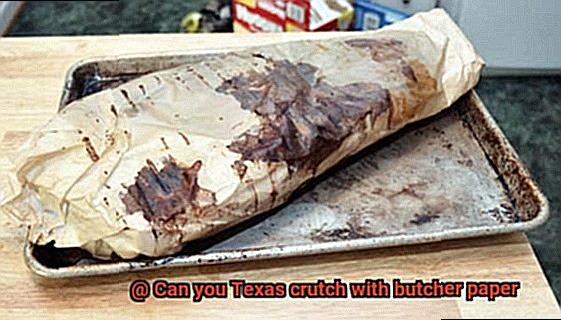
Let It Rest
Once your meat is cooked, let it rest for at least 30 minutes before unwrapping it from the butcher paper. This will allow the juices to redistribute throughout the meat, resulting in a more tender and flavorful end product.
Use a Spray Bottle
Before wrapping the meat in butcher paper, spritz it with some apple juice or another liquid of your choice to keep it moist. This will help keep the meat tender and juicy throughout the cooking process.
Other Alternatives to Foil When Smoking Meat
Smoking meat is a beloved cooking technique that involves slow-cooking meat over low heat for several hours. One popular method is the Texas crutch, which involves wrapping the meat in foil to help retain moisture and speed up cooking time. However, concerns about the environmental impact and potential health risks of using foil have led many people to search for alternatives.
Thankfully, there are several excellent options available that can help you achieve tender, juicy meat without using foil. Let’s explore some of these alternatives:
- Butcher paper: This thick, durable paper is commonly used in the meatpacking industry and can withstand high temperatures. Wrapping your meat in butcher paper during the smoking process can help trap in moisture and flavor while also reducing cooking time.
- Parchment paper: This non-stick paper is commonly used in baking and can be a great option when smoking meat. It can be used to wrap meat during the smoking process, preventing sticking while also trapping in moisture.
- Banana leaves: These traditional wrapping materials are used in many cultures and can be found in specialty food stores. Wrapping your meat in banana leaves imparts a unique flavor and helps keep it moist during cooking.
- No wrapping at all: While it may take longer than using foil or other wrappings, smoking your meat without any wrapping can produce a deeper flavor and more pronounced smoke ring.
By experimenting with these alternatives, you can find the perfect option to suit your preferences. Each method can help retain moisture and flavor while also reducing your environmental impact.
wiuzK-_cA20″ >
Conclusion
To sum it up, the Texas Crutch technique is a widely used smoking method that involves wrapping meat in foil or butcher paper during the final stages of smoking. While foil has been the traditional choice for many pitmasters, butcher paper has gained popularity due to its unique features such as breathability and flavor-enhancing abilities. However, choosing the right type of uncoated, food-grade paper that is free from chemicals or dyes is crucial.
Butcher paper offers several advantages over foil including better airflow and moisture retention, durability under high heat, and a natural bark on the meat. Additionally, it’s more eco-friendly than foil since it can be composted or recycled after use.
When using butcher paper for the Texas Crutch method, make sure to wrap your meat tightly but not too tightly and keep an eye on the cooking process to ensure even cooking. Other alternatives to foil when smoking meat include parchment paper, banana leaves, and no wrapping at all.
By following these expert tips and tricks for using butcher paper in the Texas Crutch method, you can achieve mouth-watering tenderness and flavor that will leave your guests impressed. So why not give it a shot at your next BBQ event?

